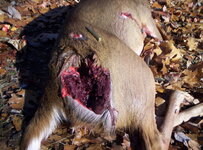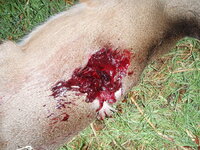Navigation
Install the app
How to install the app on iOS
Follow along with the video below to see how to install our site as a web app on your home screen.
Note: This feature may not be available in some browsers.
More options
Style variation
You are using an out of date browser. It may not display this or other websites correctly.
You should upgrade or use an alternative browser.
You should upgrade or use an alternative browser.
6.5 creed vs 30-06
- Thread starter Gabulldog91
- Start date
- Joined
- Oct 22, 2014
- Messages
- 13,447
The fact remains that the 30-06 has more killing power.
Can you please explain plainly what “more killing power” is, and how does it show on/in an animal?
Laramie
WKR
- Joined
- Apr 17, 2020
- Messages
- 2,753
See post #59.Can you please explain plainly what “more killing power” is, and how does it show on/in an animal?
Laramie
WKR
- Joined
- Apr 17, 2020
- Messages
- 2,753
I think there is absolutely.Is there no room for a middle ground, i.e. only use the minimum needed to have a reasonable margin for error?
The problem is reasonable margin for error means something different to each person.
Hunters will disagree as long as there remains a broad range of options. Nothing wrong with that in my opinion.
- Joined
- Oct 22, 2014
- Messages
- 13,447
See post #59.
I have. Your note the article answered my question. You stated- “The fact remains that the 30-06 has more killing power”
I ask you again- what is “killing power”?
Woodrow F Call
Lil-Rokslider
- Joined
- Apr 27, 2019
- Messages
- 165
For starters, this thread went in a different direction when CoStick and others derailed it by claiming the 6.5 was equal to the 30-06. Regarding the OPs question, I think the 6.5 is an excellent choice for deer out to 600+.
That said, in response to yours and other questions and thoughts, I believe the article below would be a good read for most. I have taken well over 100 big game animals throughout my hunting career. I have also guided another 100 or so successful hunts. None of that makes me an expert in the slightest. As this article states, we all develop person biases. The author below does his best to offer an objective opinion to killing power.
"Energy, the ability to do work (or damage in the case of a bullet fired from a rifle) is an important component of killing power. It should be obvious to practically anyone that a bullet carrying more energy when it hits the target has the potential to do more damage than a bullet carrying less energy. Energy is what powers such important functions as penetration, bullet expansion, and tissue destruction. In the U.S. it is measured in foot pounds (ft. lbs.)."
"Potential"
There are a couple of problems with using energy as a means of determining how well a bullet will kill.
1. Doesn't account for bullet construction
2. The equation places a premium on velocity over mass as velocity is squared
Arrows kill well, big slow bullets kill well, hard ball .30-06 doesn't kill well and energy doesn't account for these discrepancies.
6.5cm is easier to shoot and in the right bullet does extreme damage.
LookinforDirt
WKR
For backcountry deer. Not targets, not elk, no specific weight mentioned. Just deer. Neither out to 600. 400-450 and under, either and a hill of beans.Not trying to start a war but if yall have to pick one, which would it be? Rifles weigh the same and you can handload for both. Which is getting the nod for back country deer ( out to 600 )?
Need more factors to choose one over the other.
I am not buying it.This is where the thread went away from just a 6.5 CM for deer thread.
And here...
I have stated numerous times that the 6.5 is a very capable deer caliber.
In my opinion, both reach their effective range on deer sized game around the 1000 yard mark. Way further than 99% of hunters will ever need.
I have opinions on the caliber's effectiveness on larger game but those boil down to personal preferences and biases, not facts. Just like most others on here will have opinions and personal biases.
The fact remains that the 30-06 has more killing power. It absolutely may not be needed in most situations but I am in the camp that I would rather have more than I need vs maybe not having enough. Plenty of others with opposite mindsets prefer to only use the minimum needed- that is their prerogative.
The are better indicators, IMHO. In fact, I don't think "energy" even needs to be a part of the equation if we are trying to measure "killing power" or whatever that is.
I chose these Hornady Precision Hunter loads as we are getting the most similarly-constructed bullets started off at about as close to the same velocity as possible. The 6.5 Creedmoor starts the 143 ELDX at 2700 and the .30-'06 starts the 178gr ELDX at 2750. This is about as close as we can get to true "apples to apples" comparison of two cartridges using bullet weights optimum for that cartridge. I believe that although we rarely agree with each other on most things, I think most would agree that 140-class bullets are optimum for the 6.5 Creed and 180-class are optimum for the .30-06.
Here are the velocity/energy/sectional density figures of the 143gr ELD-X fired from a 6.5 Creedmoor followed by the 178gr ELD-X fired from a .30-'06 at 500 yards:
2030/1308/2.93
1969/1533/2.68
The .30-06 load is still packing that arbitrary "1,500 ft lbs of energy to kill an elk" at 500 yards, while the 6.5 Creedmoor load falls short of that old-school threshold. If "energy" is what matters, the .30-'06 should be superior, right? It should have more "killing power," right?
Wrong.
The Creed's 143gr ELD-X is traveling nearly 100 FPS faster at this distance than the '06's 178gr ELD-X, even though it was started out slower. The 143gr 6.5mm bullet also has a (much) greater SD than the 178gr .308 bullet. As such, you can absolutely expect that the long 143gr bullet with higher SD traveling at a higher velocity would absolutely out-penetrate and cause more tissue damage than the shorter, less dense 178gr bullet of the same construction traveling at a lower velocity.
In this apples-to-apples scenario, I would absolutely choose this 6.5 Creedmoor load over the .30-06 version, EVERY SINGLE TIME. The two loads are essentially equal to about 450 yards, then the Creedmoor starts pulling away and gains even more the further out you go.
Energy just doesn't matter to me. Placement, impact velocity and bullet construction do, because these are the things that combine to damage tissue. If you accept that a greater and deeper wound channel and the most tissue destruction are the things most likely to represent the most "killing power," you'd have to choose the 6.5 Creedmoor, as well.
Lawnboi
WKR
Honest question @Formidilosus
Say you have similar to the above example of same construction bullets, ignoring ballistics and recoil, both 143 and 178 eldx hitting at basically the same velocity.
Can we expect more damage from the 178? Based on it being more weight to expand? SD comes into play but how much once that bullet expands at 2k fps?
Similar to comparing say a 77tmk to a 130tmk to a 175tmk.
I have a 3006 that I like shooting too, only reason I really ask.
I’m a firm believer that the bullet matters more than the case behind it.
Say you have similar to the above example of same construction bullets, ignoring ballistics and recoil, both 143 and 178 eldx hitting at basically the same velocity.
Can we expect more damage from the 178? Based on it being more weight to expand? SD comes into play but how much once that bullet expands at 2k fps?
Similar to comparing say a 77tmk to a 130tmk to a 175tmk.
I have a 3006 that I like shooting too, only reason I really ask.
I’m a firm believer that the bullet matters more than the case behind it.
Coopsdaddy
WKR
06
Dirtriding4life
Lil-Rokslider
Does the frangible versus bonded/mono bullet matter in the discussion?
A bonded or mono .308 caliber expanded 1.5x leaves a .462” wound channel however the .264 caliber expanded is only .396”. I would not expect a difference of .066” in wound channel to determine if an animal dies from the wound or not, however the larger hole would be likely to disrupt more tissue and bleed out faster assuming equal penetration.
I can imagine with a frangible bullet the diameter is less important and getting good penetration from high SD becomes the priority.
Maybe this is what everyone is referencing when they mention the “choose the right bullet” comment? I ask because I‘m partial to mono’s with their minimal bloodshot and ability to eat right up to the hole.
A bonded or mono .308 caliber expanded 1.5x leaves a .462” wound channel however the .264 caliber expanded is only .396”. I would not expect a difference of .066” in wound channel to determine if an animal dies from the wound or not, however the larger hole would be likely to disrupt more tissue and bleed out faster assuming equal penetration.
I can imagine with a frangible bullet the diameter is less important and getting good penetration from high SD becomes the priority.
Maybe this is what everyone is referencing when they mention the “choose the right bullet” comment? I ask because I‘m partial to mono’s with their minimal bloodshot and ability to eat right up to the hole.
Last edited:
Laramie
WKR
- Joined
- Apr 17, 2020
- Messages
- 2,753
I am not buying it.
The are better indicators, IMHO. In fact, I don't think "energy" even needs to be a part of the equation if we are trying to measure "killing power" or whatever that is.
I chose these Hornady Precision Hunter loads as we are getting the most similarly-constructed bullets started off at about as close to the same velocity as possible. The 6.5 Creedmoor starts the 143 ELDX at 2700 and the .30-'06 starts the 178gr ELDX at 2750. This is about as close as we can get to true "apples to apples" comparison of two cartridges using bullet weights optimum for that cartridge. I believe that although we rarely agree with each other on most things, I think most would agree that 140-class bullets are optimum for the 6.5 Creed and 180-class are optimum for the .30-06.
Here are the velocity/energy/sectional density figures of the 143gr ELD-X fired from a 6.5 Creedmoor followed by the 178gr ELD-X fired from a .30-'06 at 500 yards:
2030/1308/2.93
1969/1533/2.68
The .30-06 load is still packing that arbitrary "1,500 ft lbs of energy to kill an elk" at 500 yards, while the 6.5 Creedmoor load falls short of that old-school threshold. If "energy" is what matters, the .30-'06 should be superior, right? It should have more "killing power," right?
Wrong.
The Creed's 143gr ELD-X is traveling nearly 100 FPS faster at this distance than the '06's 178gr ELD-X, even though it was started out slower. The 143gr 6.5mm bullet also has a (much) greater SD than the 178gr .308 bullet. As such, you can absolutely expect that the long 143gr bullet with higher SD traveling at a higher velocity would absolutely out-penetrate and cause more tissue damage than the shorter, less dense 178gr bullet of the same construction traveling at a lower velocity.
In this apples-to-apples scenario, I would absolutely choose this 6.5 Creedmoor load over the .30-06 version, EVERY SINGLE TIME. The two loads are essentially equal to about 450 yards, then the Creedmoor starts pulling away and gains even more the further out you go.
Energy just doesn't matter to me. Placement, impact velocity and bullet construction do, because these are the things that combine to damage tissue. If you accept that a greater and deeper wound channel and the most tissue destruction are the things most likely to represent the most "killing power," you'd have to choose the 6.5 Creedmoor, as well.
You are completely forgetting to account for expansion and momentum. The 143 grain bullet will lose momentum at a much faster rate than the 178 grain bullet. SD does matter but the figures change drastically as bullets deform upon impact. Energy absolutely does matter. It is only part of the equation, but it certainly can't be ignored.
- Joined
- Oct 22, 2014
- Messages
- 13,447
Honest question @Formidilosus
Say you have similar to the above example of same construction bullets, ignoring ballistics and recoil, both 143 and 178 eldx hitting at basically the same velocity.
Can we expect more damage from the 178?
Yes, but not as much as one would think- around a .5” larger wound. Penetration around the same. You could shoot a hundred animals with each lay them side by side and you would be able to tell which did which.
- Joined
- Oct 22, 2014
- Messages
- 13,447
You are completely forgetting to account for expansion and momentum. The 143 grain bullet will lose momentum at a much faster rate than the 178 grain bullet. SD does matter but the figures change drastically as bullets deform upon impact.
So how does momentum damage tissue?
Energy absolutely does matter. It is only part of the equation, but it certainly can't be ignored.
Ok, tell me how many foot pounds of energy creates what size wound?
- Joined
- Oct 22, 2014
- Messages
- 13,447
The deal is that a 30cal maximized will create a larger wound than a 6.5 maximized- but no one wants that.
Who here is ok with this amount of tissue destruction-

People want to run around and talk “power” and “more effective”, then they neuter the big rounds down until they are creating less damage than a 223. The 6.5 creates larger wounds (read- more “power”) than any of “6.5’s aren’t as good as” people will ever accept.
Who here is ok with this amount of tissue destruction-

People want to run around and talk “power” and “more effective”, then they neuter the big rounds down until they are creating less damage than a 223. The 6.5 creates larger wounds (read- more “power”) than any of “6.5’s aren’t as good as” people will ever accept.
Laramie
WKR
- Joined
- Apr 17, 2020
- Messages
- 2,753
An object with more momentum simply requires more force to bring it to rest. In this instance, the bullet will need to encounter more tissue, thus damaging more, before stopping (or exiting). Obviously much more needs to be factored in but above, it wasn't even a consideration.So how does momentum damage tissue?
Ok, tell me how many foot pounds of energy creates what size wound?
The deal is that a 30cal maximized will create a larger wound than a 6.5 maximized- but no one wants that.
You make my point for me- The 30-06 is capable of creating more damage. In most hunting situations, this isn't necessary, or even ideal. However, on marginal shots, or on shots at larger game, the additional damage may mean the difference between a clean kill and a wounded animal.
- Joined
- Oct 22, 2014
- Messages
- 13,447
An object with more momentum simply requires more force to bring it to rest. In this instance, the bullet will need to encounter more tissue, thus damaging more, before stopping (or exiting). Obviously much more needs to be factored in but above, it wasn't even a consideration.
Ok, how much momentum does it take to go “what” distance in tissue?
You make my point for me- The 30-06 is capable of creating more damage. In most hunting situations, this isn't necessary, or even ideal. However, on marginal shots, or on shots at larger game, the additional damage may mean the difference between a clean kill and a wounded animal.
Yes, and so does a rocket. What’s the point? Bet money you aren’t using bullets that cause additional damage in tissue. Almost no is.
Was this from a 6.5 or a 30cal?

Your “additional damage” for “‘marginal shots” is a fallacy because people aren’t using it. What shot would a 30/06 result in death, but a 6.5 in the exact same spot will not? No theories, or figures, or anything else that has nothing to do with the actual wound created by the bullet. Please tell me how deep the maximized 30 cal will penetrate, and how wide that wound will be. Please do the same for the 6.5.
Laramie
WKR
- Joined
- Apr 17, 2020
- Messages
- 2,753
Why so combative? Is it not ok to state facts on this forum? Touch a nerve?
You are asking for things that you know can't be provided because each situation is different. Again, You have proved my original stance- the 30-06 is a more powerful weapon. It hits harder. It delivers more energy. It is up to each individual to decide if they want or need that. I don't care if people want to hunt moose with a .223 or elephant with a 6.5CM- to each their own.
I do however think it is bad to not acknowledge the differences. Almost every major publication out there has- no reason it can't be mentioned here is there?
Food for thought-
You want a rifle firing a 180 grain well constructed bullet in this situation or a rifle firing a 143 grain well constructed bullet at the same speed? I know what 99% of people would choose.

Why should it be different in this situation?

You are asking for things that you know can't be provided because each situation is different. Again, You have proved my original stance- the 30-06 is a more powerful weapon. It hits harder. It delivers more energy. It is up to each individual to decide if they want or need that. I don't care if people want to hunt moose with a .223 or elephant with a 6.5CM- to each their own.
I do however think it is bad to not acknowledge the differences. Almost every major publication out there has- no reason it can't be mentioned here is there?
Food for thought-
You want a rifle firing a 180 grain well constructed bullet in this situation or a rifle firing a 143 grain well constructed bullet at the same speed? I know what 99% of people would choose.

Why should it be different in this situation?

- Joined
- Oct 22, 2014
- Messages
- 13,447
Why so combative? Is it not ok to state facts on this forum? Touch a nerve?
I’m asking for reality, not feelings. How many deer and elk have you killed with 6.5’s and 30/06’s?
You are asking for things that you know can't be provided because each situation is different.
I can tell you to the inch the average wound depth and width for most 6.5 and 30cal bullets at most impact velocities.
Again, You have proved my original stance- the 30-06 is a more powerful weapon. It hits harder. It delivers more energy. It is up to each individual to decide if they want or need that. I don't care if people want to hunt moose with a .223 or elephant with a 6.5CM- to each their own.
I do however think it is bad to not acknowledge the differences. Almost every major publication out there has- no reason it can't be mentioned here is there?
Name one publication that you are referencing that has a clue about terminal ballistics?
Food for thought-
You want a rifle firing a 180 grain well constructed bullet in this situation or a rifle firing a 143 grain well constructed bullet at the same speed? I know what 99% of people would choose.
View attachment 457369
Why should it be different in this situation?
View attachment 457372
It won’t make a difference for either animal with either bullet. Do you think 99% of people have any clue about bullets, killing, or ballistics?
LongWayAround
WKR
- Joined
- Aug 10, 2015
- Messages
- 3,599
I don't have much to contribute here, but...
Yesterday, I shot a 1" steel plate at 600yd with 6.5CM and 147 ELD-M. The impacts on that plate were about 3/8ths of an inch deep.
I could take a swing at a bone-in shoulder with a hammer and do a lot more damage than I could on a steel plate.
Yesterday, I shot a 1" steel plate at 600yd with 6.5CM and 147 ELD-M. The impacts on that plate were about 3/8ths of an inch deep.
I could take a swing at a bone-in shoulder with a hammer and do a lot more damage than I could on a steel plate.
Similar threads
- Replies
- 22
- Views
- 4K
- Replies
- 8
- Views
- 398
Featured Video
Latest Articles
- TT#64 Josh Boyd Elk Hunting Strategies for Every Season
- Aaron Davidson of Gunwerks
- TT#63 Dirk Durham’s Art of Elk Calling
- BIG Buck Stories with the Dirty Giants Podcast
- TT#62 Brian Barney Hunting Bulls without Calling
- Hoyt Alpha AX-2 SD Review
- Kuiu Kenai vs Outdoor Vitals Vario Hooded Jacket Review
- Hoyt RX-9 Ultra Review
- Hunting Vampire Bucks & Building an Optics Kit
- Darton Sequel ST2 35 Review
